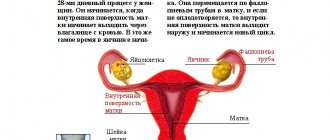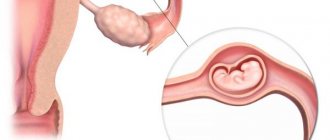Discharge during menstruation is normal
The average interval for the menstrual cycle is three to five weeks. On the other hand, the period of menstruation ranges from three days to one week. Anything that does not fall within these boundaries may be a pathology.
Every girl's menstruation symptoms are quite similar. Typically, menstruation begins in the form of light discharge, which intensifies over time. By the end of menstruation, the discharge gradually disappears. At first, the blood discharge is characterized by a bright red color. Later they change their color to dark brown or black.
Clots during menstruation are also considered normal, since during this period blood clots form in the fair sex. The color of these clots can be either dark red or bright red. Discharge without clots should alert a woman, as this is a deviation from the norm. In this case, it is recommended to consult a doctor. In addition, you should seek specialized help if you doubt whether you are having menstruation or normal bleeding, or if you experience constant pain these days.
Recommendations from experts
If brown discharge appears instead of menstruation, it is recommended:
- Change gaskets regularly throughout the cycle;
- Do not use tampons during pregnancy;
- Wear cotton underwear of the appropriate size;
- Do not wash the vagina! This will disrupt the natural flora and cause infection.
To correctly determine the cause of the discharge, it is first necessary to find out whether the patient is pregnant - this is what determines the choice of treatment.
During pregnancy, any deviation from the norm should be taken seriously. Here, not only the health of the expectant mother, but also her child may suffer.
Although pregnancy and menopause are common causes of brown vaginal discharge, you should not neglect your health. Contact your gynecologist as soon as you feel any unusual sensations.
Video - brown discharge instead of menstruation is a sign of pregnancy
https://youtu.be/8I1UlTq-7co
Difference between bleeding and menstruation
It will be possible to distinguish between heavy menstruation and bleeding directly during the interview with the patient. It is typical for a woman to become accustomed to the characteristics of her own secretions. If there are any differences during the cycle, the girl will definitely notice it. The lady should pay attention to the following factors:
- Increased volume of menstruation;
- Continuous bleeding;
- The discharge becomes liquid;
- The discharge is scarlet, deep red or crimson in color;
- The presence of clots in blood discharge is not observed;
- The special smell of blood disappears.
Thus, if you notice that the course of your current periods is different from the previous ones, you should contact a specialist to find out what is causing this. Only a doctor can name the main cause of the pathology.
Heavy menstruation
An impressive number of women face this problem. Menorrhagia is a completely normal phenomenon, but in order to exclude the formation of complications, you should be periodically observed by your doctor. As a rule, heavy bleeding has its own specific meaning: in most cases, a woman undergoes changes in the functioning of the female organs.
The cause of the phenomenon may be:
- deficiency of B vitamins;
- the presence of a spiral in the uterus;
- interrupted pregnancy or abortion;
- blood clot formation;
- the presence of gynecological disease or other diseases.
In order to exclude the possibility of pathology, it is enough to find out what reasons are considered normal:
- The presence of a predisposition that is transmitted in the family through the female line.
- Copious discharge is present during the first menstruation in life.
- Women undergoing menopause undergo changes.
You can distinguish heavy periods using characteristic signs:
- the presence of general weakness throughout the body;
- presence of nausea and fainting;
- severe and prolonged headaches;
- increased body temperature;
- the discharge is so much higher than normal that the pad has to be changed every hour;
- The duration of menstruation can exceed nine days.
Heavy periods are distinguished by the fact that they make changes in a woman’s appearance:
- The skin becomes unhealthy and pale.
- Hair splits a lot and falls out.
- Nails break and lose their former density.
- Habitual physical training becomes difficult and overwhelming.
Having familiarized yourself with how to determine what is bothering a girl, heavy periods or bleeding, it should be mentioned that treatment, as a rule, begins with an examination and examination by a doctor. After making a diagnosis, the doctor will prescribe individual medications and procedures to eliminate the disease.
Causes of bleeding
Let's look at the most common causes of uterine bleeding:
- Malignant neoplasms of the uterus;
- Climax;
- Childbirth;
- Endometriosis;
- Young age;
- Inflammatory diseases;
- Pregnancy;
- Hormonal imbalance;
- Blood diseases;
- Hormonal drugs;
- Ovarian diseases;
- Benign neoplasm.
First of all, it is worth understanding that in adolescence, as well as during menopause, menstrual irregularities are quite often observed. If this problem has been bothering a girl for a long time, she may well get used to the irregular cycle. Sometimes the appearance of bleeding may not be detected immediately. Girls whose current menstruation is their first cannot yet know all the features of this process. Usually, the cycle of young ladies gradually stabilizes, and the amount of discharge becomes normal.
In addition, bleeding may occur as a result of taking hormonal contraceptives. In this case, it is strictly recommended to consult a doctor for advice. If necessary, you will be prescribed pills that will help restore the balance of the necessary hormones, after which such discharge will stop.
If the patient complains of massive discharge without inclusions and clots, or of prolonged discharge, which is accompanied by the leakage of a small amount of dark blood, then most likely the cause is a benign neoplasm. Also, spotting can make itself felt during pregnancy. In this case, the cause may be a ruptured tube, as well as detachment or improper placement of the placenta. The consequences can be fatal for both the woman and her child.
Self-treatment before visiting a gynecologist
If there is heavy uterine bleeding, you must urgently call an ambulance. Before her arrival, you can take the following measures to reduce discharge:
- Lie down so that your legs are higher than your torso.
- Provide plenty of fluids.
- Apply dry ice to the groin area of the abdomen.
After hospitalization and relevant studies and tests, doctors will decide whether the patient should see a gynecologist. Perhaps the symptom requires the intervention of other specialists.
Medications are often used to reduce blood loss: Tranexam, Vikasol, Dicynon. Taking each of these drugs requires consultation with a gynecologist, careful reading of the instructions for use and strict adherence to dosing rules.
https://youtu.be/LykLfM5YGwY
Menstruation is a cyclical shedding of the inner mucous layer of the uterus. Every woman of reproductive age regularly experiences similar bleeding from the vagina. But when such bleeding is not associated with menstruation, or the nature of menstruation differs from the norm in quantity, time and associated symptoms, this may be the first sign of pathology.
Timely detection of the problem will allow you to avoid serious diseases, including cancer. Read this article to learn how to understand periods or bleeding in teenage girls, women of reproductive and menopausal age.
Read in this article
Classification of discharge
There are three main types of uterine bleeding: normal, conditionally normal and pathological.
| Type of bleeding | Characteristic |
| Normal | During each menstrual cycle, a woman experiences menstrual flow. |
| Conditionally normal | Sometimes discharge appears in the postovulatory or preovulatory period. Implantation type bleeding is also considered conditionally normal. |
| Pathological | This type of bleeding can occur in women of any age. They are divided into several subtypes: functional, organic and systemic. |
Symptoms
Since this condition is quite dangerous for a woman’s health, it is worth considering in more detail the symptoms of both uterine and menstrual bleeding. It will help you learn to recognize and differentiate between these two types of bleeding. A small list of symptoms that can help you distinguish bleeding from menstruation:
- An increase in the volume of blood released;
- Increased duration, as well as changes in the nature of menstruation;
- Disappearance of clots.
As a result of the pouring out of blood, the amount of fluid in the bloodstream decreases. In this case, the following symptoms of shock may occur:
- Cardiopalmus;
- Excessive sweating;
- The occurrence of chills;
- Sharpening of facial features;
- Reduced blood pressure;
- Dizziness;
- Periodic occurrence of vomiting;
- The gaskets begin to get wet much faster than before;
- Loss of consciousness;
- Paleness of the skin and mucous membranes.
The following symptoms are typical for the development of anemia:
- The discharge becomes lighter;
- Cardiopalmus;
- Decreased levels of hemoglobin and red blood cells;
- Dizziness;
- Layering and brittleness of nails, hair loss;
- Lethargy;
- Fatigue quickly;
- Poor assimilation of the information received.
If you still cannot distinguish between menstruation and uterine bleeding on your own, then you need to seek help from a doctor. He will not only help you understand the type of bleeding, but also prescribe treatment if necessary.
What are the differences between menstruation and pathological processes?
Certain symptoms have been identified that indicate the difference between menstruation and bleeding:
- frequent change of pads with maximum absorbency during the day (more than 1 piece per hour or two);
- menstruation lasts more than seven days;
- a lot of blood clots;
- general weakness, loss of appetite, lethargy, dizziness;
- unbearable aching pain in the lower abdomen and lumbar region;
- spotting bloody leaks after intimacy with a man;
- anemia.
You need to contact a gynecologist for several more visual signs during menstruation:
- pallor of the skin of the face;
- hair often falls out, nail plates become brittle and white;
- it is very difficult to perform usual physical activities;
- menstruation comes irregularly;
- the occurrence of bloody, spotting discharge between menstruation.
Share link:
What to do, treatment
We recommend that you stop taking medications and listen to the following recommendations in order to stop heavy discharge:
- Drink plenty of fluids;
- Reduce physical activity;
- Relax in the fresh air more often;
- Do not visit steam rooms or take baths;
- Avoid alcoholic drinks and coffee.
In order to reduce heavy discharge, it is recommended to place a cool heating pad on your tummy, holding it in this position for 10-15 minutes. In addition, you should consult a gynecologist.
Experts recommend taking various decoctions to restore blood in the body. Nettle, viburnum bark, wheatgrass, oak bark and cinquefoil are perfect for this. The most effective are decoctions of nettle, oak bark and rose hips. They help stop bleeding and also perform a preventive function.










